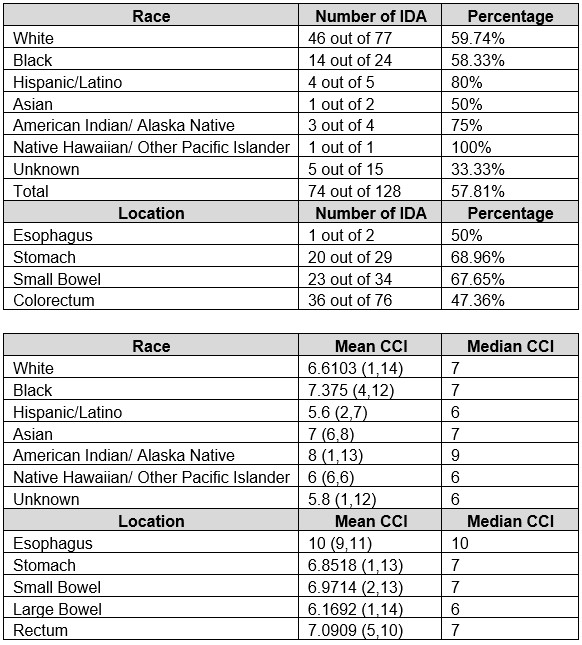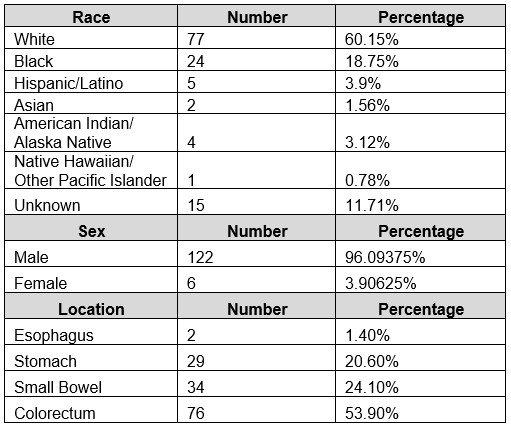Monday Poster Session
Category: GI Bleeding
P3051 - Gastrointestinal Angioectasia Diagnosed in Veteran Population Are Most Likely Associated With High Charlson Comorbidity Index Scores and Iron Deficiency Anemia
Monday, October 27, 2025
10:30 AM - 4:00 PM PDT
Location: Exhibit Hall

Leo Sakai, DO
Loma Linda University Health
Loma Linda, CA
Presenting Author(s)
Leo Sakai, DO1, Christian Jackson, MD2
1Loma Linda University Health, Loma Linda, CA; 2VA Loma Linda Healthcare System, Loma Linda, CA
Introduction: Iron deficiency anemia (IDA) has been associated with gastrointestinal angioectasias. There are few studies that use Charlson Comorbidity Index (CCI) to describe the burden of comorbidity in this patient population. Moreover, there a few studies that have investigated the relationship among IDA, angioectasias, and CCI. The primary aim of this study is to determine the prevalence of IDA and relationship of CCI within a veteran population diagnosed with gastrointestinal angioectasia.
Methods: A single center retrospective epidemiological study was conducted on patients who had endoscopic confirmation of gastrointestinal angioectasia from 2015 to 2018. An electronic chart review was performed using the computerized patient record system (CPRS) and our endoscopic database (ProVation, Minneapolis, Minnesota ). Demographic factors, type of endoscopy, CCI scores, indication for endoscopy, date of endoscopy, location of angioectasia, and presence of IDA were included. IDA was determined by a ferritin less than 41 or transferrin saturation less than 20% in the setting of anemia. Chi squared t-tests were used to determine statistical significance.
Results: 128 patients were identified who were diagnosed with gastrointestinal angioectasia. The median age was 74 years (range, 52-100). Demographics are included on Table 1. The majority of gastrointestinal angioectasia were observed in the colorectum (53.9%) followed by small bowel (24.1%). 57.8% of the patients included were diagnosed with IDA. When compared to all other sites, IDA was most likely to be diagnosed in the small bowel (p=0.048). The overall mean CCI score was 6.6 and mean CCI score among patients diagnosed with IDA was 7.3. When comparing CCI score and IDA, patients with a CCI ≥ 5 were more likely to be diagnosed with IDA (p=0.000375). When compared to Caucasians, African Americans were more likely to have a CCI ≥ 5 (p=0.04).
Discussion: Even though the colorectum had the highest percentage of angioectasias, IDA was more likely to be observed in the small bowel. Patients with IDA and African Americans were noted to have highest levels of comorbidities, which were statistically significant. Prospective, randomized controlled trials will need to be performed to determine the effect on rebleeding, hospitalizations, and mortality.

Figure: Patient Demographic and Distribution of Angioectasia

Figure: Prevalence of IDA and CCI Scores Based on Race and Location of Angioectasia
Disclosures:
Leo Sakai indicated no relevant financial relationships.
Christian Jackson indicated no relevant financial relationships.
Leo Sakai, DO1, Christian Jackson, MD2. P3051 - Gastrointestinal Angioectasia Diagnosed in Veteran Population Are Most Likely Associated With High Charlson Comorbidity Index Scores and Iron Deficiency Anemia, ACG 2025 Annual Scientific Meeting Abstracts. Phoenix, AZ: American College of Gastroenterology.
1Loma Linda University Health, Loma Linda, CA; 2VA Loma Linda Healthcare System, Loma Linda, CA
Introduction: Iron deficiency anemia (IDA) has been associated with gastrointestinal angioectasias. There are few studies that use Charlson Comorbidity Index (CCI) to describe the burden of comorbidity in this patient population. Moreover, there a few studies that have investigated the relationship among IDA, angioectasias, and CCI. The primary aim of this study is to determine the prevalence of IDA and relationship of CCI within a veteran population diagnosed with gastrointestinal angioectasia.
Methods: A single center retrospective epidemiological study was conducted on patients who had endoscopic confirmation of gastrointestinal angioectasia from 2015 to 2018. An electronic chart review was performed using the computerized patient record system (CPRS) and our endoscopic database (ProVation, Minneapolis, Minnesota ). Demographic factors, type of endoscopy, CCI scores, indication for endoscopy, date of endoscopy, location of angioectasia, and presence of IDA were included. IDA was determined by a ferritin less than 41 or transferrin saturation less than 20% in the setting of anemia. Chi squared t-tests were used to determine statistical significance.
Results: 128 patients were identified who were diagnosed with gastrointestinal angioectasia. The median age was 74 years (range, 52-100). Demographics are included on Table 1. The majority of gastrointestinal angioectasia were observed in the colorectum (53.9%) followed by small bowel (24.1%). 57.8% of the patients included were diagnosed with IDA. When compared to all other sites, IDA was most likely to be diagnosed in the small bowel (p=0.048). The overall mean CCI score was 6.6 and mean CCI score among patients diagnosed with IDA was 7.3. When comparing CCI score and IDA, patients with a CCI ≥ 5 were more likely to be diagnosed with IDA (p=0.000375). When compared to Caucasians, African Americans were more likely to have a CCI ≥ 5 (p=0.04).
Discussion: Even though the colorectum had the highest percentage of angioectasias, IDA was more likely to be observed in the small bowel. Patients with IDA and African Americans were noted to have highest levels of comorbidities, which were statistically significant. Prospective, randomized controlled trials will need to be performed to determine the effect on rebleeding, hospitalizations, and mortality.

Figure: Patient Demographic and Distribution of Angioectasia

Figure: Prevalence of IDA and CCI Scores Based on Race and Location of Angioectasia
Disclosures:
Leo Sakai indicated no relevant financial relationships.
Christian Jackson indicated no relevant financial relationships.
Leo Sakai, DO1, Christian Jackson, MD2. P3051 - Gastrointestinal Angioectasia Diagnosed in Veteran Population Are Most Likely Associated With High Charlson Comorbidity Index Scores and Iron Deficiency Anemia, ACG 2025 Annual Scientific Meeting Abstracts. Phoenix, AZ: American College of Gastroenterology.
